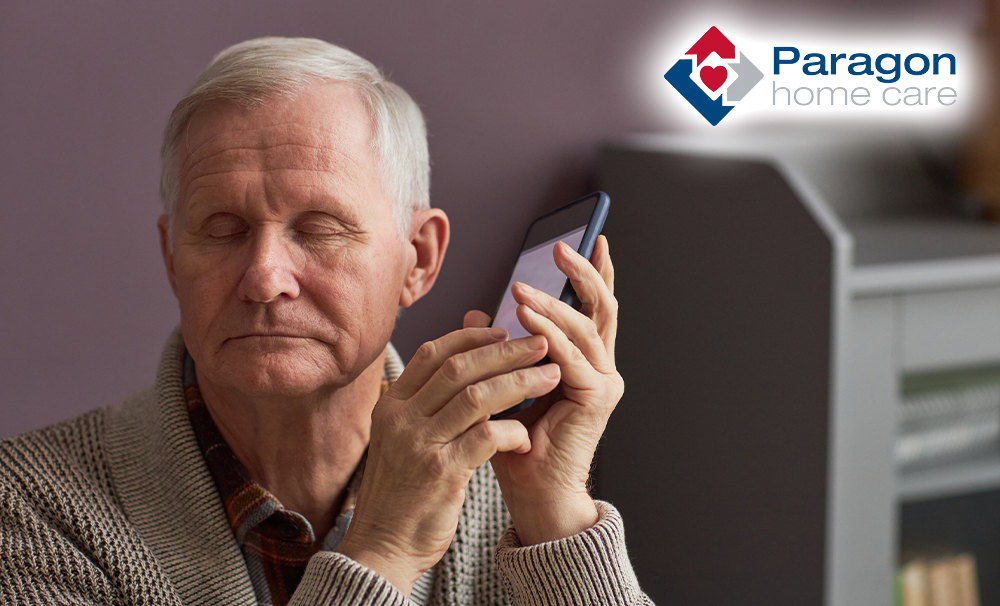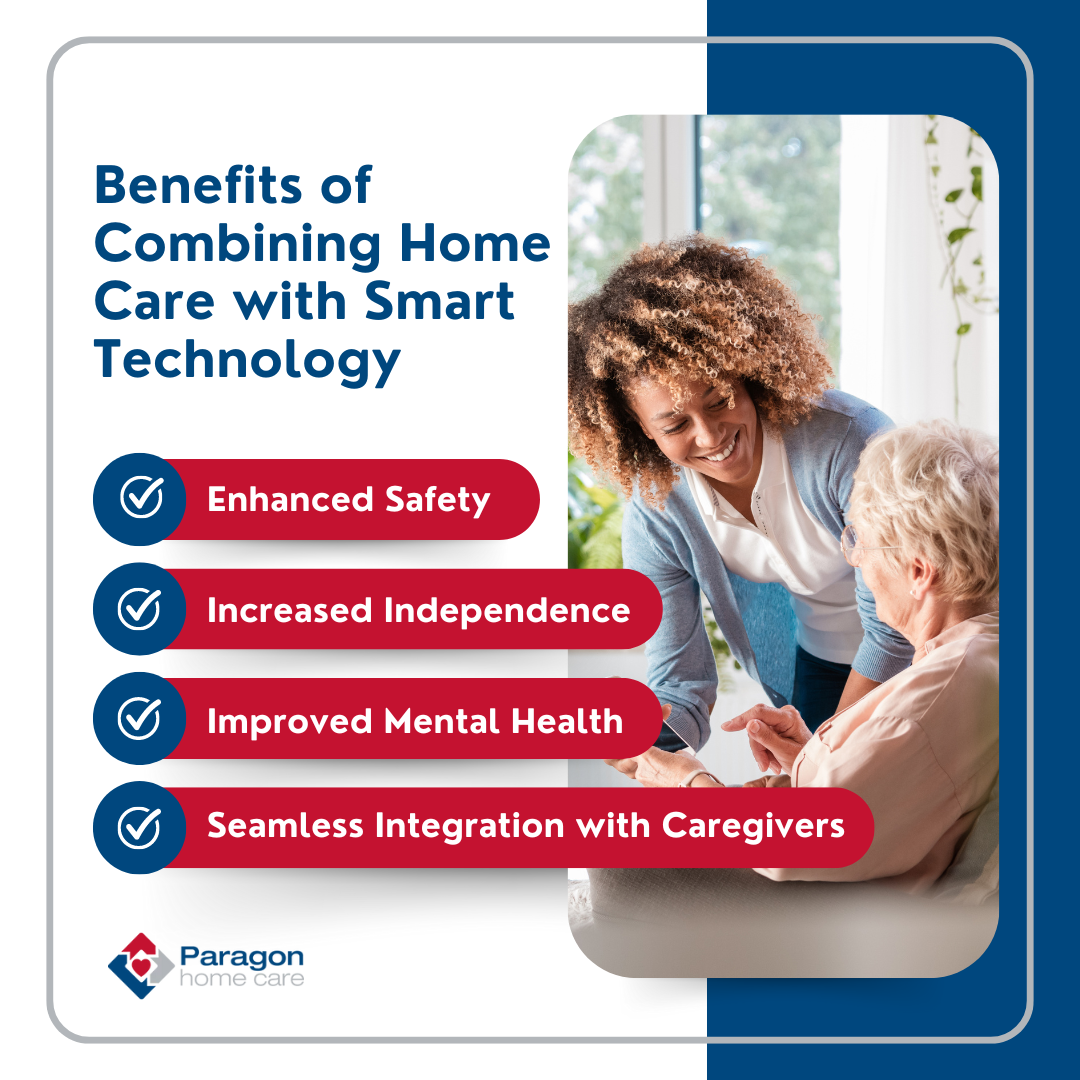Many of us take being able to see properly for granted—not only for the simple pleasures of enjoying life’s beauty but also for the functionality it brings to daily activities. Good vision allows us to navigate our homes, manage medications, and cook meals—all of which create a sense of independence. For visually impaired adults, losing this ability can feel like a significant loss of freedom.
Tasks that were once second nature can become daunting, and the home environment may feel less secure. However, home care services can also enhance routine and promote greater autonomy. When paired with smart home technology, the quality of life for visually impaired adults can flourish, allowing them to tackle challenges independently while benefiting from home care’s safety and support. Join us as we explore how home care coupled with smart home adjustments can offer a way to maintain both comfort and safety in everyday living.
Daily Impact of Vision Impairment in Older Adults
Many older adults already require assistance in their daily routines to remain safe and supported. When you add vision impairment to the mix, the need for assistance increases as simple tasks become more challenging. Vision impairment can significantly affect several aspects of an adult’s life, including:
- Eating
- Getting dressed
- Driving
- Shopping
- Managing finances
- Walking
- Physical activities
- Social life
These challenges can increase a visually impaired adult’s risk of falls and injuries, making it essential that their routine and environment are adapted to accommodate vision loss. Creating a visually impaired-friendly home and utilizing home care services can make a world of difference in maintaining their safety and quality of life.
The Role of Home Care Services
Home care services support older adults in their daily tasks while allowing them to maintain as much independence as possible. Caregivers provide assistance based on each individual’s needs, offering help with personal care, health management, meals, chores, and transportation. Home care can be precious for visually impaired adults, as it not only addresses their physical requirements but also focuses on their emotional well-being.
- Personalized Assistance: Home care services take into consideration the specific needs of each adult – especially those who are visually impaired. Depending on the severity of the impairment, personalized assistance might include managing medications, offering daily living support, or helping with grooming and dressing. Adults with partial vision may still be able to perform certain tasks independently. At the same time, those who are fully visually impaired may need comprehensive help with activities like bathing, housekeeping, and laundry. The level of involvement is customized to ensure each adult receives the right amount of support.
- Emotional and Physical Well-Being: Beyond physical care, home care services also play a vital role in enhancing the emotional well-being of adults. Visually impaired adults often face increased isolation, as they are less active and independent than they once were. Caregivers provide essential companionship, offering social interaction that helps combat loneliness. From preparing meals together to engaging in conversation, these interactions can significantly boost a patient’s mood and overall quality of life.
Home care services address the practical and emotional needs of visually impaired adults, ensuring they can live safely in their homes while staying connected to the world around them.
Smart Home Adjustments for Visually Impaired Adults
Hiring home care services doesn’t mean you can’t make additional adjustments to help visually impaired adults flourish at home. With today’s smart technology and smart home features, there are so many ways you can utilize these devices to improve your daily routine and overall quality of life. Let’s explore some top smart home adjustments that can enhance a visually impaired adult’s experience at home.
- Voice-Controlled Systems: Many smart home systems rely on touch panels, smartphones, or tablets, which can be difficult or impossible for visually impaired adults to use. However, voice-controlled systems allow them to easily manage lighting, appliances, and entertainment options. Popular AI-powered virtual assistants like Amazon Alexa, Google Assistant, and Apple Siri are excellent options for sight-free control.
- Smart Lighting: While you don’t initially think lighting makes a huge difference for visually impaired people, it can help eliminate shadows and make the most of their sight level. Smart lighting solutions can make a significant difference even for those with some degree of light perception hence. Voice-controlled or app-enabled smart lights and motion-sensor lighting help with navigation and reduce the need for manual operation. As a result, this makes it easier and safer for visually impaired individuals to move around their homes.
- Audible Alerts: When your eyesight is impaired, it is important to utilize the strengths of other senses, like hearing. Audible alert devices can assist with daily activities by providing notifications for phone calls, doorbells, and alarms. Devices like the ADA 121 Audio Visual Alert System pair a strobe light with a loud buzzer for extra awareness. At the same time, tools like the Reizen Portable Pocket-Sized Liquid Level Indicator prevent overfilling cups by providing an audible alert.
- Smartphone Apps and Assistive Technology: It goes without saying that there’s an app for everything nowadays. Smartphone apps and assistive technology have made significant strides in supporting visually impaired adults. Apps like Be My Eyes, Google Lookout, and Speech Services by Google offer human-assisted vision or AI-powered solutions to assist with daily tasks. These tools enhance independence by offering real-time guidance and accessibility features that are easy to use.
- Non-Tech “Smart” Home Adjustments: For those not ready to invest in smart tech innovative, there are other “smart” home adjustments that can improve life for visually impaired adults. Tactile alerts, such as textured warning tiles or symbol communicators, can be implemented throughout the home to enhance awareness. Keeping the home clean and free of clutter is another essential adjustment—something a home care provider can assist with, as it can be challenging for someone with visual impairments.
Benefits of Combining Home Care with Smart Technology
Home care and smart technology aim to simplify life and enhance safety, especially for visually impaired adults. When combined, they create an environment where visually impaired adults can remain in their homes while minimizing health risks. While home care workers provide essential support, they can’t monitor every moment of the day. Smart technology acts as an extra set of eyes, offering assistance and security when caregivers must focus on other tasks.
Let’s explore some of the key ways this combination can improve the quality of life for visually impaired adults at home:
Enhanced Safety
Feeling safe at home is important for visually impaired adults’ overall comfort and well-being. While caregivers provide a foundational level of safety, smart technology can further enhance this by helping prevent accidents and falls. Automated systems and alerts, like motion sensors and voice-activated devices, can act as a safety guide throughout the home by creating an added layer of protection for visually impaired adults.
Increased Independence
No one is ready to give up their independence, but everyday tasks can make this feel inevitable for visually impaired adults. Relying on home care can feel like a loss of autonomy, but with the integration of smart technology, you don’t have to throw away your independence. Smart apps and systems enable visually impaired adults to manage many tasks on their own, from controlling appliances to navigating their living spaces. This technology allows caregivers to focus on other responsibilities while the adult retains the ability to handle key activities themselves.
Improved Mental Health
A CDC study revealed that 1 in 4 adults who are visually impaired report feelings of anxiety or depression. This report goes to show how there are serious mental health challenges that often accompany visual impairment. By regaining a sense of control and self-sufficiency through the combination of smart technology and home care, visually impaired adults can experience an improvement in their emotional well-being. From completing personal tasks to engaging with others through smart platforms, these tools empower adults to feel less isolated and more accomplished.
Seamless Integration with Caregivers
Caregivers can’t be on duty 24/7, and hiring around-the-clock support can be costly and unrealistic for long-term care. Smart technology bridges this gap by allowing caregivers and family members to provide remote assistance. Through video cameras, health monitors, smart home sensors, and video calls, caregivers can stay connected and provide necessary support without being physically present. This integration offers visually impaired adults the support they need while preserving their autonomy and reducing the need for frequent in-person visits.
Home Care Services in Northern Virginia | Paragon Home Care
Paragon Home Care has been a trusted provider of personal and companion care services for senior citizens in Northern Virginia since 2013. Our mission comes with a passion for helping others and delivering consistent, reliable care. We dedicate ourselves to inspiring independence and comfort while ensuring each of our seniors has a caregiver who perfectly fits their needs.
Paragon serves our community through various services, including Personal and Companion Care, Care Management, and Medical Director Services for Home Care, as well as Transportation Assistance and our Helping Neighbors Program.
If you’re interested in starting with Paragon Home Care, don’t hesitate to call us at (703) 942-8950 or contact us to schedule a complimentary assessment. We look forward to serving you and your loved ones with compassion and excellence.
Additional Resources:
- https://www.davechaffey.com/assistive-technology/ios-for-blind-and-visually-impaired/the-best-android-and-ios-mobile-apps-for-blind-and-partially-sighted-people-2022/
- https://www.eastersealstech.com/2016/03/02/5-alerting-indicators-for-blind-and-visually-impaired/
- https://restechtoday.com/smart-home-technology-enhancements-for-the-visually-impaired/
- https://adatile.com/why-tactile-warnings-are-important/
- https://www.iotforall.com/the-health-benefits-of-smart-home-technology#:~:text=Because%20of%20smart%20technology%2C%20elderly%20residents%20can,caregivers%20to%20potential%20issues%20as%20they%20arise.
- https://www.medplushealth.ca/blog/the-future-of-smart-home-assistants-home-health-care-products-looks-bright/#:~:text=Communication:%20Communication%20is%20very%20important.%20Smart%20home,calls%20and%20even%20get%20answers%20to%20questions.
- https://www.rnib.org.uk/living-with-sight-loss/independent-living/lighting/


